25 wedding photos show the very first LGBT couples to marry in their countries and the stories behind them
Mia Jankowicz

- LGBTQ couples around the world have fought to have their love recognized with the same marriage rights as straight people.
- Thirty countries worldwide allow same-sex marriage, according to the Pew Research Center. But most of these gains did not come without a fight from campaigners and couples in love.
- The latest country to legalize it was Northern Ireland, when Sharni Edwards and Robyn Peoples married in February 2020.
- Scroll down to see some photos from the very first same-sex marriages in 15 countries. Every picture records not just a couple's big day, but also a historical milestone.
- Visit Insider's homepage for more stories.
Every wedding is an important day.
But some marriages make history — such as the unions that signal a country's acceptance of LGBT rights for the first time.
In February, 27-year-old Sharni Edwards and Robyn Peoples, 26, became the first gay couple to legally marry in Northern Ireland. The country is the world's latest to legalize same-sex marriage.
"Our love is personal but the law which said we couldn't marry was political," Peoples said, according to the BBC.
"While this campaign ends with Sharni and I saying 'I do,' it started with people saying 'No' to inequality. By standing together, we've made history."
Behind them are the long histories of other LGBT couples and their friends, who tried everything from legal loopholes, to crossing borders, to cross-dressing to get hitched.
Scroll down to see photos from the very first same-sex marriages in 15 countries, and the stories behind them.
Ruqayyah Moynihan and Sophia Ankel contributed reporting.
Read the original article on InsiderFinally, here's Sharni Edwards and Robyn Peoples in Northern Ireland, who married in February 2020. In her wedding speech, Peoples thanked the activists who campaigned alongside them to make same-sex marriage a reality. Cheers, ladies.
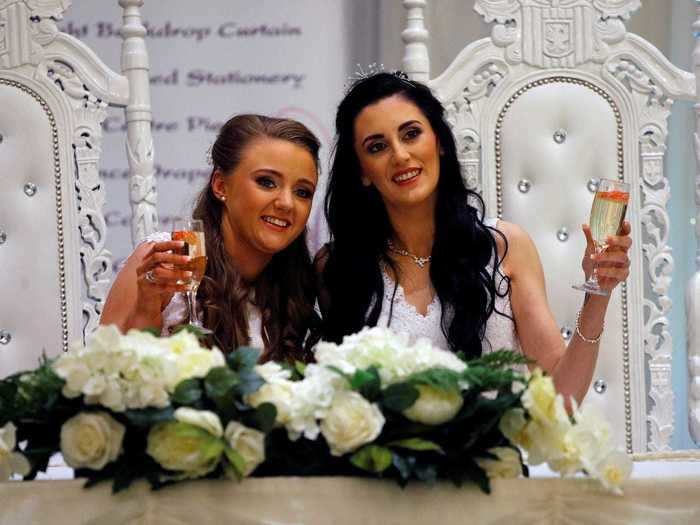
The couple married in Carrickfergus on February 11, 2020.
"We didn't set out to make history. We just fell in love," Edwards said prior to the wedding, according to the BBC.
"Our message to the world on our wedding day is: we are equal," she continued. "Our love is personal, but the law which said we couldn't marry was political."
"We are delighted that, with our wedding, we can now say that those days are over."
But they weren't the first. In 2012, You Ya-ting and Huang Mei-yu caused a stir with a symbolic wedding at a Buddhist temple in Taoyuan county, northern Taiwan.
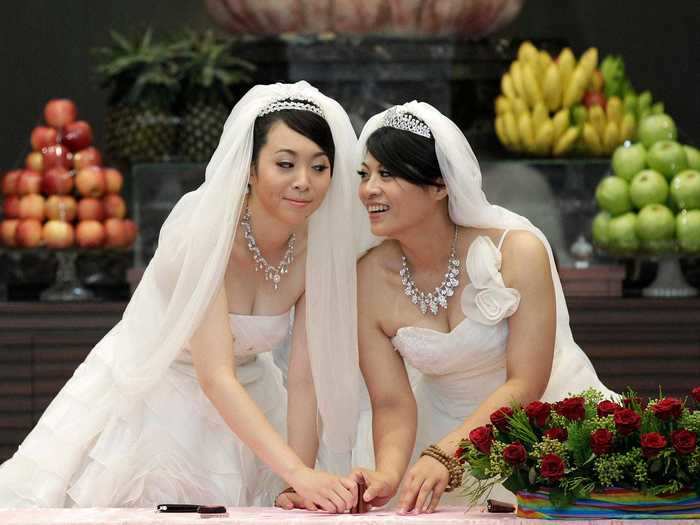
With the influential blessing of Buddhist social activist Shih Chao-hwei, they hoped the ceremony would speed along a landmark gay marriage bill that had been languishing since 2003, CNN reported.
According to CNN, Huang told reporters: "I remember when I told my parents that we would get married, their first question was, 'Is this legal?'"
"I could only say to them that it would soon, but I didn't know when would be considered soon. So we hope it will become legal. For us and for our families, it is very important."
When that day finally came in 2019, Huang said she was "nervous" but "very happy," Agence France-Presse reported.
"Now that same-sex marriage is legally recognized, I think my parents might finally feel that it's real and stop trying to talk me into getting married [to a man]," she said.
Over in Asia, Taiwan became the first country to make same-sex marriage legal on May 24, 2019. This couple registered their marriage on that very day, and celebrated with a rainbow-colored party.
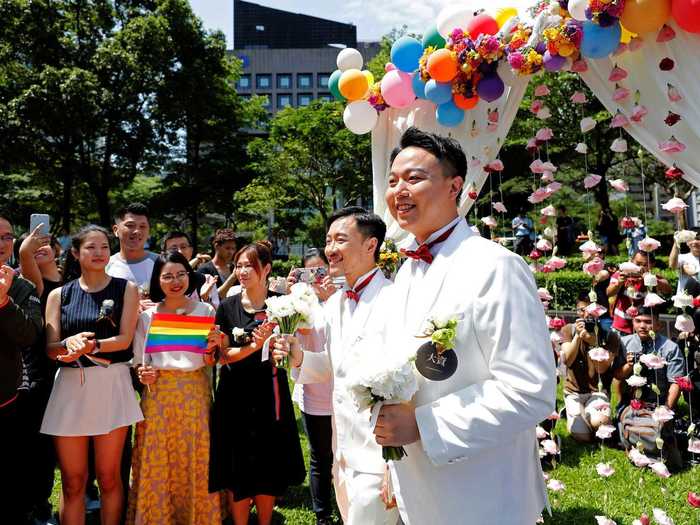
Two years later, Karl Kreile got to marry his longtime partner Bodo Mende in Germany, and became one of the country's first LGBT married couples. "This is a day we've waited a long time for," Kreile said.
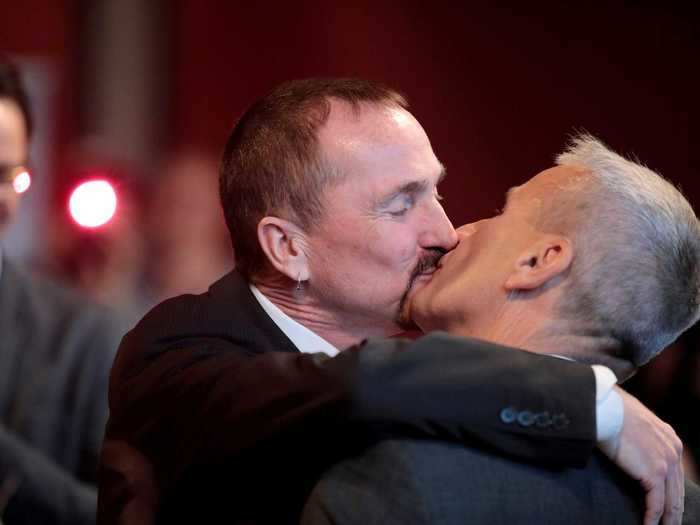
Kreile and Mende married in October 2017, the same month Germany's parliament approved marriage equality.
They had been together 38 years before their wedding, The Guardian reported. They married at a registry office in Berlin.
Across the Atlantic, Richard Dowlin and Cormac Gollogly "raced" to be one of the first married gay couples in County Tipperary, Republic of Ireland, in October 2015.
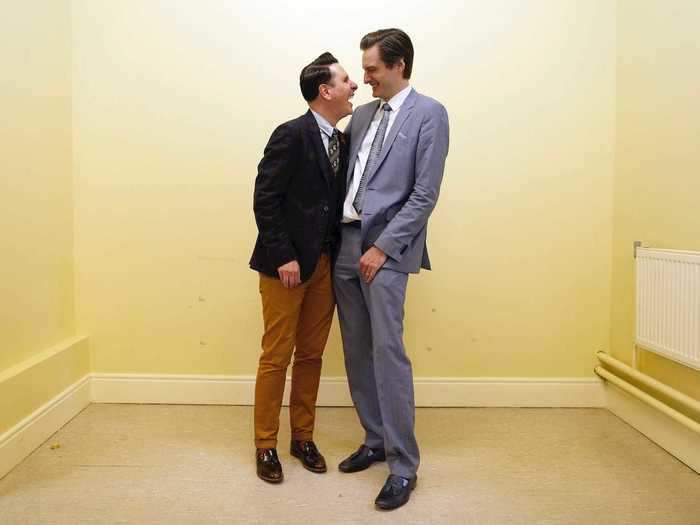
The couple first met in The George pub in Dublin, with Gollogly telling the Irish Independent in November 2015: "Our eyes met across the room and a friend who was with me asked what guy I was interested in, and I pointed at Richard [Dowlin] and he caught me."
According to the paper, they "raced" to be the first to be married at the County Tipperary registry office at 8:30 a.m. the day gay marriage was legalized, though they had already been joined by a civil union one month earlier.
A two-thirds majority had voted in favour of gay marriage in a referendum in May that year after a campaign Gollogly described to the Independent as "really well-run".
"We had friends coming home from London and Australia to vote who had never voted before," he told the Irish Independent.
Then-health minister Leo Varadkar also revealed he was gay during the campaign. He later became Taoiseach.
On the other side of the country, Xu Na wiped tears from Xue Mengyao's face in West Hollywood. They were one of seven Chinese same-sex couples who won a trip to the US to be married after the Supreme Court ruling.
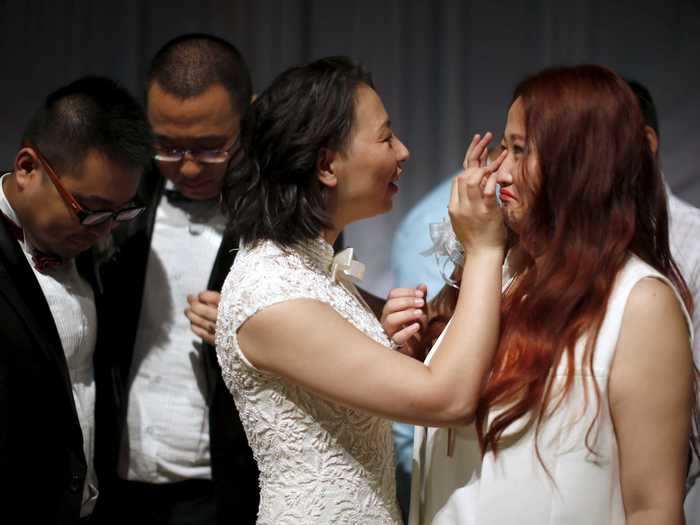
When the Supreme Court made its ruling, Chinese e-commerce giant Alibaba launched a competition for seven same-sex couples from China, where gay marriage is outlawed, Quartz reported.
Xue Mengyao and Xu Na were one of the couples who won an all-expenses-paid trip to West Hollywood, becoming one of the first couples to marry in the US on June 9.
Same-sex marriage is still not legal in China.
And a year later, in June 2015, the US Supreme Court ruled that gay marriage was constitutional. Ashby Hardesty and Rodrigo Zamora, one of the first LGBT couples to marry in the country, celebrated with a lot of glitter.
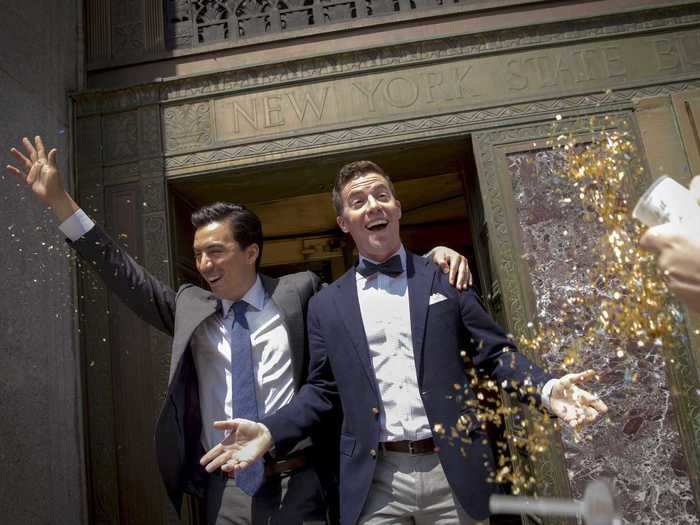
A landmark legal case on June 26, 2015, concluded that same-sex couples have the fundamental right to marry according to the 14th amendment of the constitution.
Rodrigo Zamora and Ashby Hardesty married at the New York City clerk's office that same day.
Months later, Sarah Keith and Emma Powell became one of the first gay couples to marry in England and Wales after the two countries changed their laws in 2014.
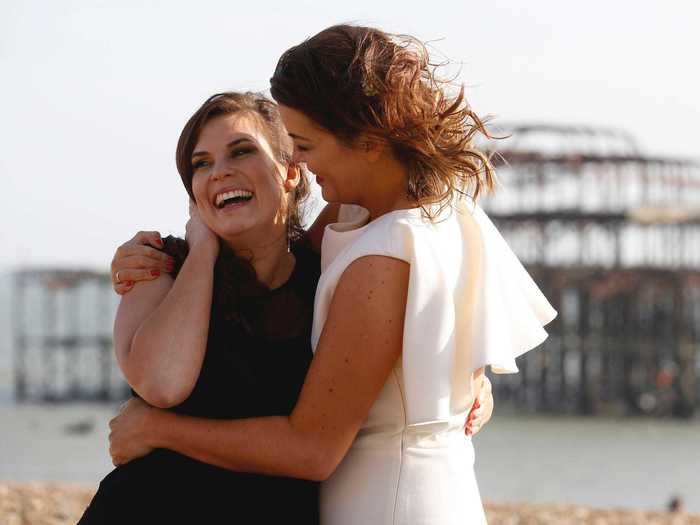
Keith and Powell met at university in 2003, and wed 11 years later in Brighton, one of England's most gay-friendly towns.
They were married in March 2014, becoming one of the first gay marriages in England and Wales after laws allowing same-sex marriage came into force that month.
They celebrated "with sushi and Champagne," Powell told HuffPost at the time.
Civil partnerships had been legal for same-sex couples in England and Wales since 2004, but the couple wanted to make it official.
"I don't think true equality exists until we have exactly the same rights," Powell told HuffPost.
Around the same time, Sergio Miranda and Rodrigo Borda married in Uruguay, the second Latin American country to legalize gay marriage. Here they are embracing after their wedding at a civil registrar's office.
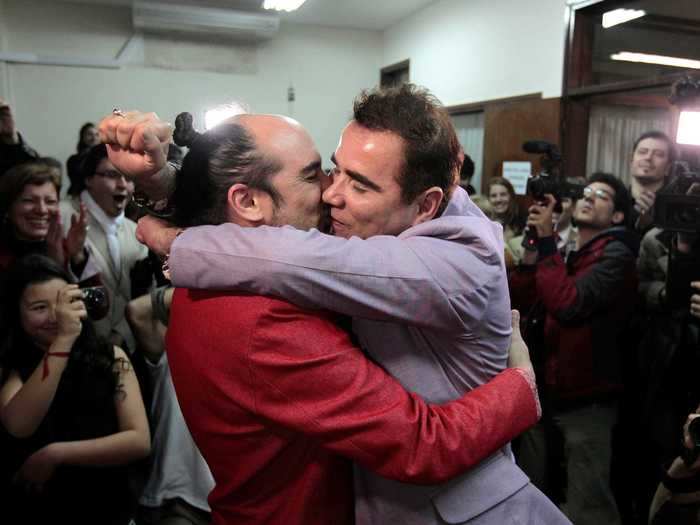
The couple, who had been together 14 years, got hitched in a civil registrar's office in Uruguay's capital Montevideo on August 22, 2013, HuffPost reported.
"We are celebrating it and sharing it because this law establishes that we all have rights," Miranda told reporters, according to HuffPost.
"There are no first and second class citizens [...] It is a very important message that Uruguay is sending to the world today."
Next was New Zealand, which legalized gay marriage in 2013. Among the first to marry was this Australian couple, who had won an all-expenses-paid wedding trip from the New Zealand tourist board.
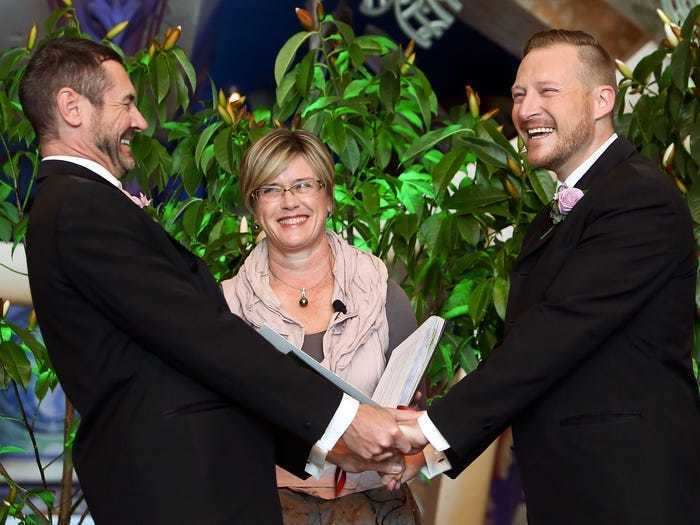
Paul McCarthy and Trent Kandler would have had to wait until 2017 before their country had legalized gay marriage.
But thanks to a competition run by the New Zealand tourist board, they were among the very first to marry in that country in 2013, according to The Sydney Morning Herald.
The competition prize included flights and a luxury hotel stay for eight of their family and friends and a full range of wedding services, the SMH reported. The couple had been together 11 years.
"As soon as I heard the news that the marriage equality bill was passed I knew I wanted to ask Trent to marry me," McCarthy told the paper.
Next was France, when Vincent Autin and Bruno Boileau married in May 2013 in Montpellier, considered France's most gay-friendly town.
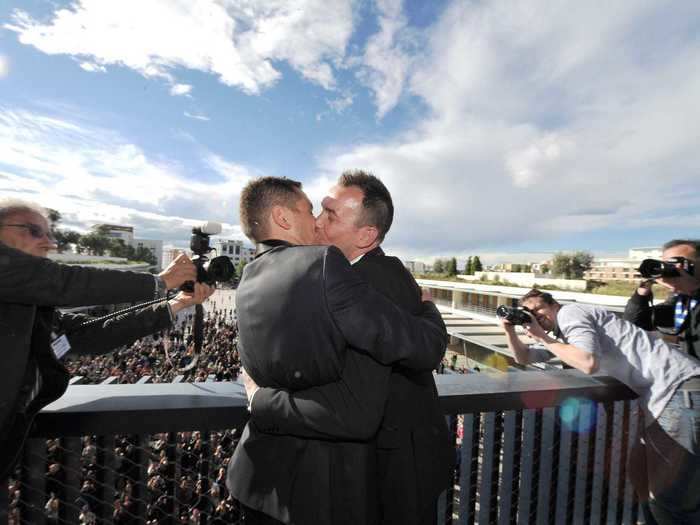
Vincent Autin proudly kissed Bruno Boileau in front of hundreds of onlookers after their wedding on May 29, 2013, after becoming the first gay couple to legally marry in their country.
They emerged from the ceremony to the tune of Frank Sinatra's "Love and Marriage," reported Deutsche Welle (DW).
They were married in Montpellier, which bills itself as France's most gay-friendly town.
But the ceremony still needed police protection, and a smoke bomb was thrown into the perimeter of the city hall where they married, DW reported.
The weekend before, hundreds of thousands people protesting gay marriage also clashed with police in Paris, the newspaper reported.
Diogo and Gustavo also married in Brazil that day.
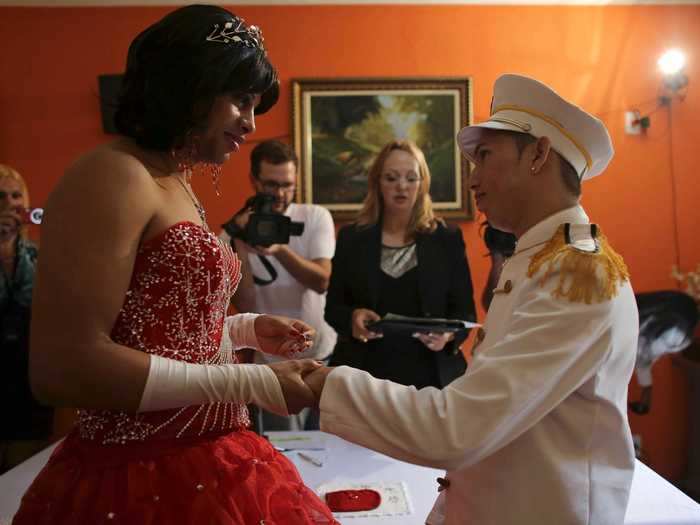
Here, Diogo hands a ring to Gustavo, at the same Campinas group of ceremonies.
But the tide in Brazil may be shifting again.
Jair Bolsonaro, the country's current right-wing president, has been vocal in his opposition to same-sex marriage, with many people fearing he could revoke those rights.
Shortly before he came to power in 2018, gay couples rushed to marry, the LA Times reported.
2013 was a big year for weddings. In March, Catia and her transgender partner Regis celebrated their wedding with Champagne in São Paulo, Brazil, after civil partnerships there were legally allowed to be converted into marriages.
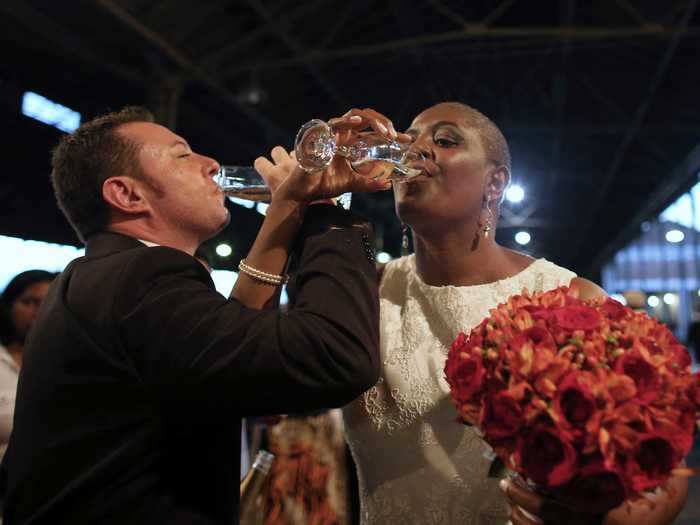
Brazil allowed civil unions from 2011, and in December 2012, judges ruled in that in the state of São Paulo, couples would no longer need to apply to have their relationships "upgraded" to marriage, Pink News reported.
So in March 2013, Catia and Regis — pictured above — joined 15 other couples to marry in São Paulo city of Campinas.
By May 15, 2013, the law had been extended to all states in the country.
Once Argentina legalized gay marriage, other Latin American couples flocked there to get married, like these two Peruvian women who were unable to wed at home.
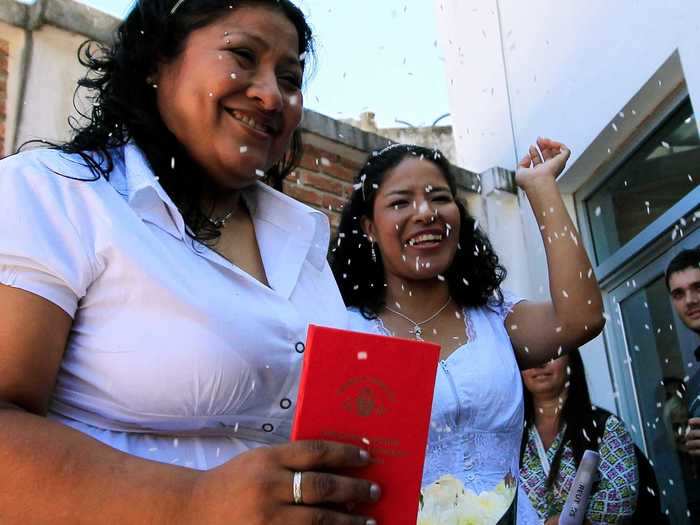
Sara Cohello and Yovana Solis were the first Peruvian women to marry at a civil registry office in Buenos Aires on Valentine's Day 2011.
They had been together for 16 years, and would prefer to have married in Peru, Peru's El Comercio newspaper reported.
Peru is yet to legalize it, but gay rights and gender equality were frequently mentioned during Peru's parliamentary elections in January 2020, The Guardian reported.
In February, LGBT activists there held a symbolic wedding to highlight the issue, according to Reuters.
Jose Maria Di Bello and Alex Freyre, in Argentina, became the first gay couple to wed in all of Latin America in 2009 after a series of legal battles. But this was fiercely criticized, with images of the couple kissing featured on many protest posters.
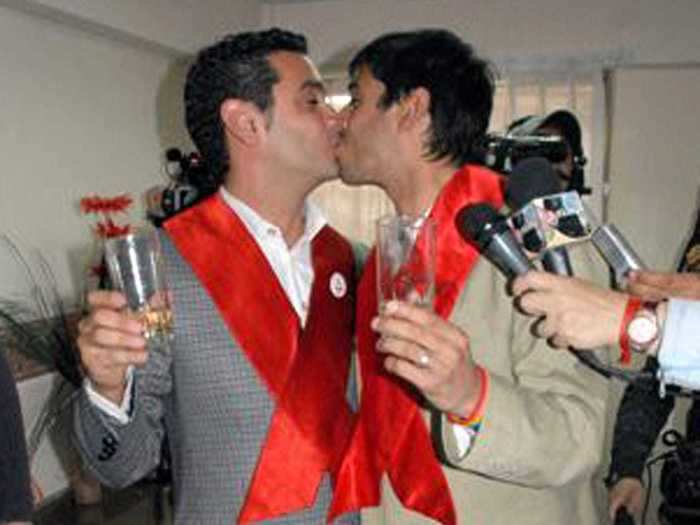
Di Bello and Freyre signed their wedding papers in Ushuaia, Argentina, in December 2009 after a legal wrangle between local and national courts over whether they could marry.
A judge in Buenos Aires gave them permission to marry on November 20, but that decision was overturned by a national judge on November 23, which was again overturned by the same Buenos Aires judge on November 24 — causing a lot of confusion, Hispanic Business reported.
Only in December did the governor of Ushuaia give them permission to marry. They decided to marry on December 28, which was also World AIDS Day, Hispanic Business said. Both men were HIV positive.
"We may have won our battle, but we don't want to be the exception," Freyre told The Observer.
But their plan to marry had divided the country, with debates raging on TV, in churches, and posters plastered onto billboards, The Observer reported.
The debate also had political consequences for Buenos Aires' mayor, Mauricio Macri. According to The Observer, posters of the two men kissing appeared across Buenos Aires, saying: "Did you vote Macri for this?"
But in July 2010 President Cristina Fernandez de Kirchner officially signed equal gay marriage rights into law. Macri later became president from 2015 to 2019.
Iceland was next. In 2010, it not only amended the law to allow "two individuals" to wed, it also became the first country in the world with an openly gay head of state.
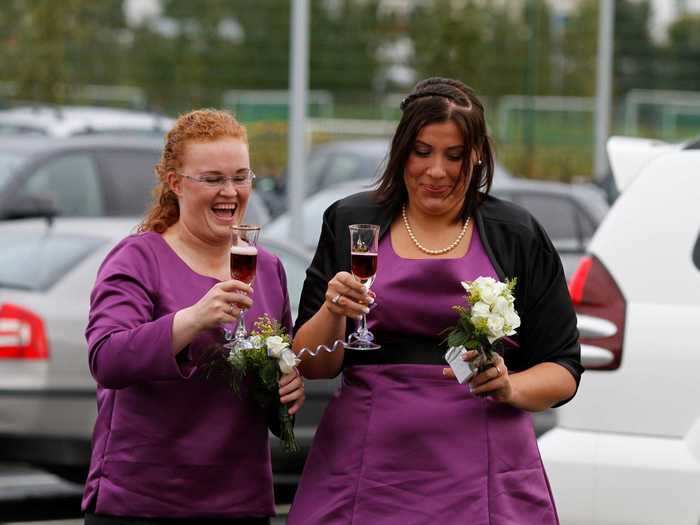
Under then-Prime Minister Jóhanna Sigurðardóttir's government, the law was amended without opposition to allow "two individuals" — rather than "a man and woman" — to be married.
It's one of the few countries where the change came relatively easy. Political scientist Gunnar Helgi Kristinsson told Reuters at the time: "It [gay marriage] has not been a big issue in national politics — it's not been controversial."
Sigurðardóttir herself enjoyed the benefits of the law, marrying her partner Jónína Leósdóttir immediately after the law was introduced in June — becoming one of the first same-sex marriages in the country.
In September, Dufa Drofn Asbjornsdottir and Diana Dogg Hreinsdottir, above, also toasted their wedding in Reykjavik.
Four years later, their marriage became a reality when a new government passed a bill to allow same-sex couples all the same rights as heterosexual couples — except the right to adopt children.
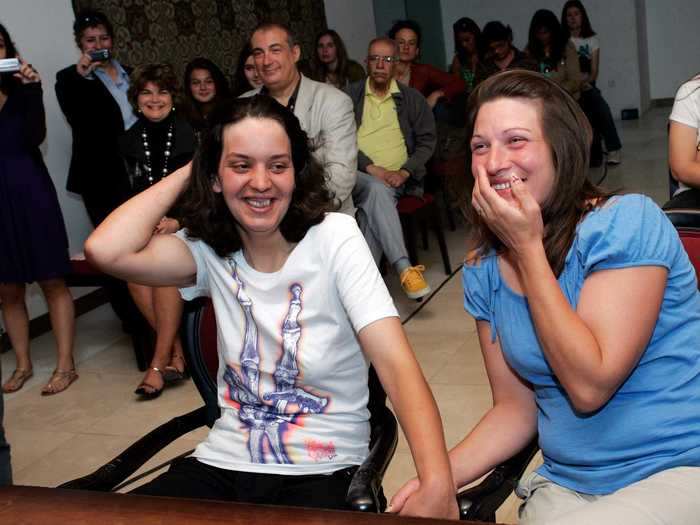
They told the BBC it felt like "a great victory, a dream come true" when they married in a Lisbon courtroom on June 7, 2010.
Their wedding came less than a month after a gay marriage law, pushed forward as part of modernizing efforts by the country's new socialist government, was ratified by then-President Aníbal Cavaco Silva.
The next LGBT wedding — or at least, the next attempt to — was in Portugal in 2006. Here's Helena Paixao and Teresa Pires leaving a registry office in Lisbon after their attempt to marry was rebuffed.
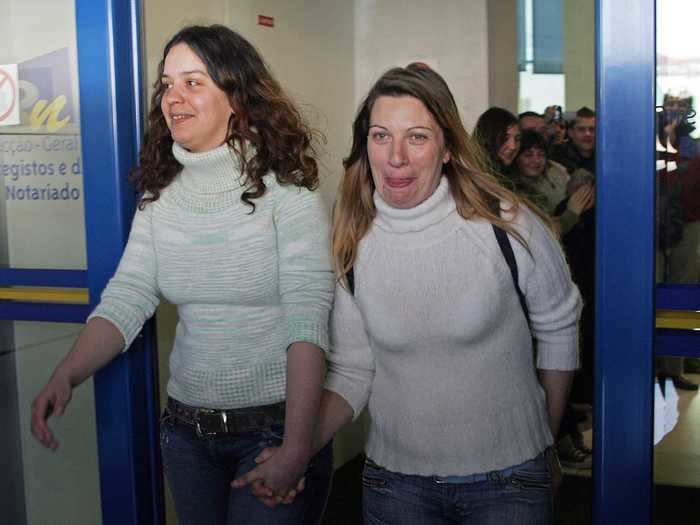
The couple had previously been in heterosexual relationships and had lived together as a couple for three years, the BBC reported.
They knew upon walking into the marriage registry that they wouldn't be able to wed legally, but tried anyway, the BBC said.
Some eleven years before South Africa legalized same-sex marriage, this couple exchanged unofficial vows at the country's first biracial gay wedding.
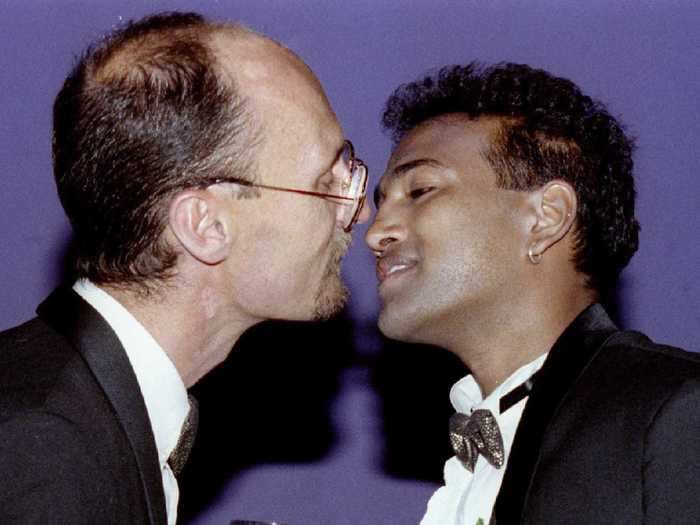
Neil Millard, left, and Venash Mooriken took their vows in a ceremony in South Africa on December 29 1995, long before the country had legalized gay marriage.
They were the first biracial gay couple to exchange vows in the country, according to Reuters.
Eleven years later, in November 2006, South Africa became the first African country to pass a law allowing gay couples to marry.
Nosiviwe Mapisa-Nqakula, the country's home affairs minister, likened the law to liberation from apartheid in a speech to the National Assembly.
"When we attained our democracy, we sought to distinguish ourselves from an unjust painful past, by declaring that never again shall it be that any South African will be discriminated against on the basis of color, creed culture and sex," she said, according to the Associated Press.
But this wasn't the first gay marriage in Spain by a long shot. In 1901, Marcela Gracia Ibeas and Elisa Sánchez Loriga had a Catholic wedding after Sánchez Loriga dressed up as "Mario."
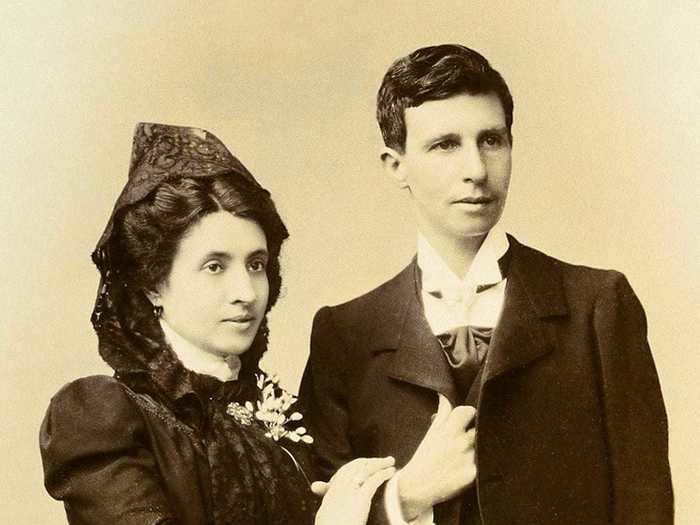
Sánchez Loriga dressed up as her fictitious cousin "Mario" after Gracia Ibeas' family was concerned about the women's relationship, according to the BBC.
After their ruse was exposed, they fled to Portugal, and moved to Argentina in 1902 under threat of a Spanish extradition order, the BBC reported.
Historians do not know much about their life in Buenos Aires after that, but records show Sánchez Loriga eventually died by suicide, the BBC said.
Their story is tragic, but one thing still stands: the marriage itself, which was never legally annulled.
Over in Spain, Emilio Menendez hid his sexuality in Gen. Francisco Franco's army and had to wait 30 years before he could legally marry Carlos Baturim in Spain in 2005.
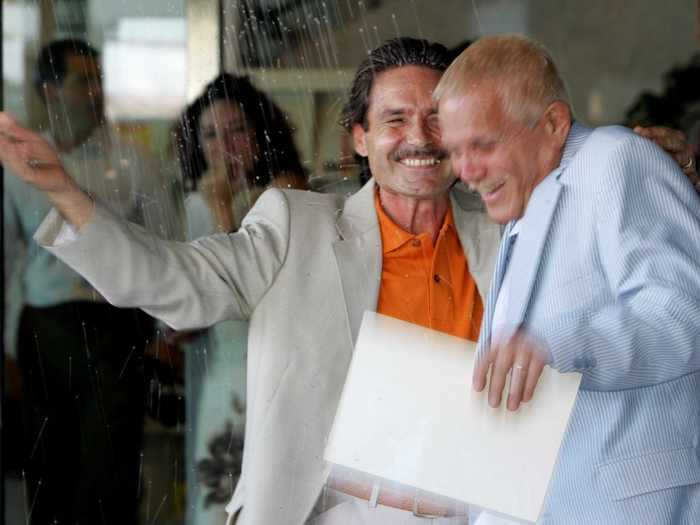
Gay men in Franco's military "knew how to hide it," Menendez told The Seattle Times.
"It was a clandestine way of living, and not just because of being a homosexual," he said. "The 70s were a time when you spoke softly about certain things, and only in private."
He met Baturim a few months before Franco died in 1975, The Seattle Times reported. The pair waited another 30 years, when the government changed the law to enable equal marriage rights for gay people.
After the wedding, Baturim told reporters: "Now we are more official. We both believe in marriage and family, and we wanted to be part of that."
And Menendez's 88-year-old mother Marina was so delighted at the wedding she paid for an Adriatic cruise for the couple's honeymoon, according to The Seattle Times.
No attack came, but the state refused to recognize the marriages. Hawkes had used a legal loophole to wed the couples and, when the government refused to register the marriages, his church sued (and eventually won).
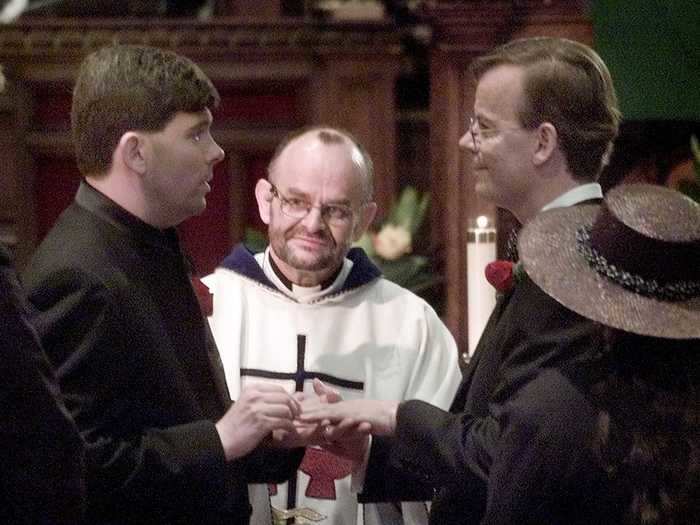
Hawkes used a legal loophole of publishing the banns – a public notice of their intention to wed – which gave him legal authority to perform the marriage without government permission.
Despite the loophole, the Ontario provincial government still refused to register the marriages, The Globe and Mail reported.
Hawkes' church then sued the city, the province, and the federal government. And in 2002 the church won its case, paving the way to a 2003 ruling that rewrote the Canadian constitution to legally recognize the equality of gay marriage.
"Nobody would have thought [same-sex marriage] possible back then," John Sproule — who later married Hawkes in their own LGBT wedding — told The Globe and Mail.
Canada's path to same-sex equality was also long and windy. In 2001, Rev. Brent Hawkes was so nervous marrying the first two gay couples, he wore a bulletproof vest under his robes in case they were attacked.
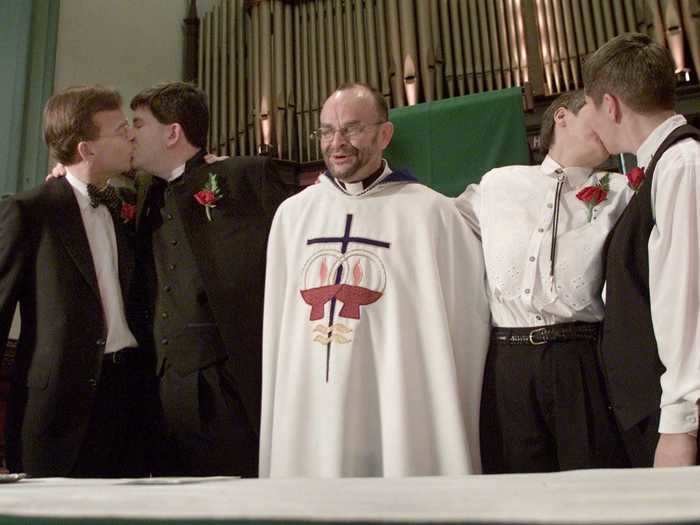
The photo above shows, from left to right: Kevin Bourassa and Joe Varnell, Hawkes, and Anne and Elaine Vautour at the Metropolitan Community Church of Toronto in January 2001.
Bourassa told The Toronto Star that he and Varnell had said goodbye to each other and to their families in case they were shot during the wedding.
"We were told we were under threat," he said. "The last words police officers said to us as we went down the aisle was, 'If you hear a shot don't move, somebody will move you, just stand still.'"
"We were told if a shot was going to come it would most likely be when we signed the papers because they'd try to stop us from signing."
Peter Lemke and Frank Wittebrood — one of the four couples — looked delighted with their wedding rings. But there was a still long way to go with global attitudes toward gay marriage.
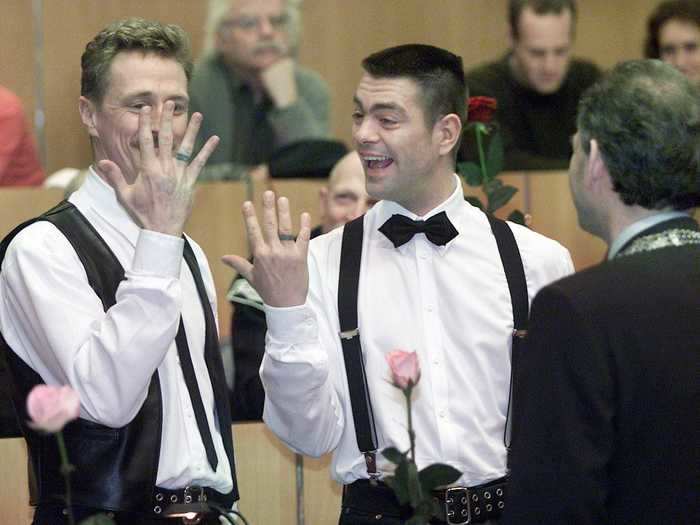
As well as supporters, there was a small crowd of protesters outside the town hall where they married, reported the BBC.
And according to Het Parool, Pasker and Kasteel were still asked by Italian media whether they were allowed to be around their neighbors' children.
The Netherlands was the first country in the world to legalize same-sex marriage in December 2000. These four couples wed at Amsterdam's town hall literally minutes after the law came into effect on April 1, 2001.
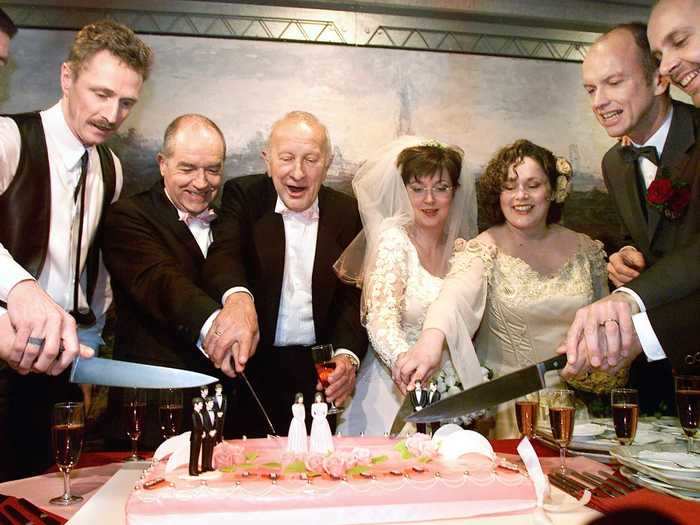
Cutting the cake and making history in the very same moment are, from left to right: Peter Lemke, Frank Wittebrood, Ton Jansen, Louis Rogmans, Helene Faasen, Anne-Marie Thus, Dolf Pasker and Geert Kasteel.
The four couples had responded to an advert in Gay Krant, a magazine that had led the campaign for equal marriage, according to the BBC.
The magazine had called for the first same-sex Amsterdammers who wanted to be married the moment the new law took effect, according to Het Parool.
The four couples were married in front of hundreds of journalists by Amsterdam's mayor. Despite the attention, Thus emphasized the normalcy of her relationship with Faasen.
"We are so ordinary, if you saw us on the street you'd just walk right past us," she said, according to the BBC.
READ MORE ARTICLES ON
Popular Right Now
Popular Keywords
Advertisement